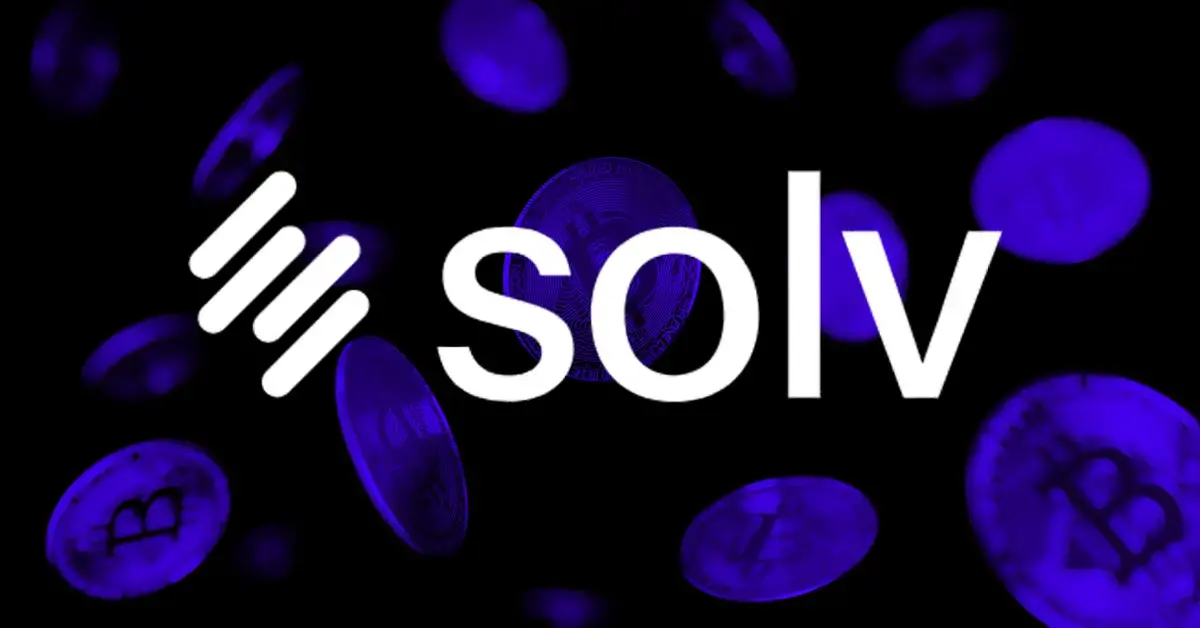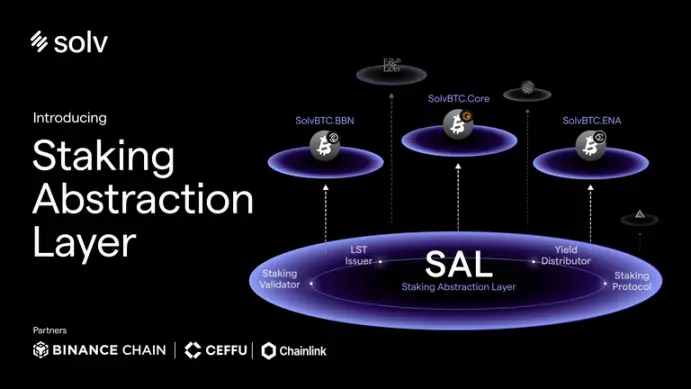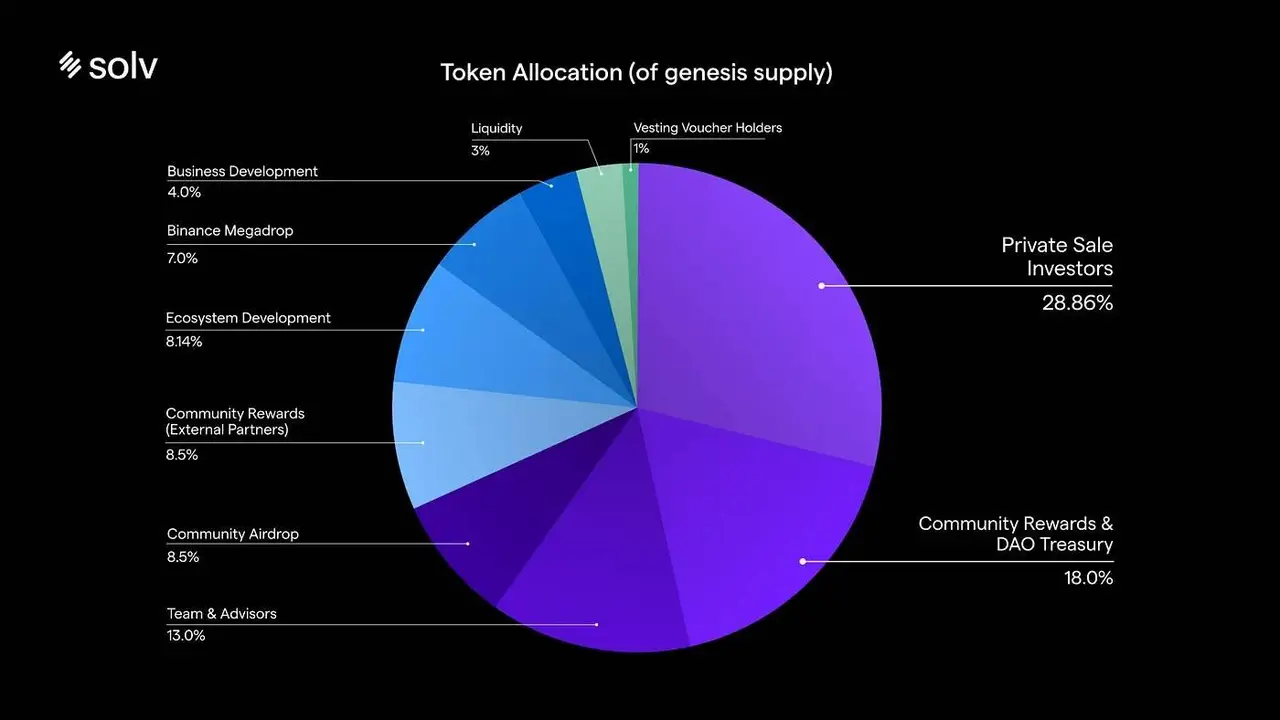Since the emergence of Bitcoin (BTC) in 2009, it has primarily been used for asset transfer and storage. With the rise of decentralized finance (DeFi) on Ethereum (ETH) during 2017-2018, the applications of Bitcoin seemed to be overlooked. In recent years, the ecosystem of applications and decentralized platforms has flourished, making Bitcoin-centered DeFi or BTCFi possible. BTCFi has now evolved into a rapidly growing world, offering efficient payment solutions, smart contract sidechains, alternative token protocols, and even technologies for issuing Bitcoin-based NFTs.
In the fast development of the BTCFi track, Solv Protocol has shifted its focus to Bitcoin-related financial innovations, launching SolvBTC, a full-chain yield Bitcoin asset aimed at providing more opportunities for Bitcoin holders. Meanwhile, Solv Protocol has also introduced the Staking Abstraction Layer (SAL), which simplifies and standardizes the cross-chain Bitcoin staking process, enabling users and developers to participate more conveniently.
1. What is Solv Protocol?
Solv Protocol is a project established in 2020, dedicated to bringing diverse asset classes and yield opportunities to the crypto space. The project initially focused on minting and trading NFTs related to financial ownership certificates, lowering the barriers to creating and using crypto financial instruments. In 2024, with the booming development of the BTCFi track, Solv Protocol has shifted its core focus to the BTCFi field, providing more choices for Bitcoin holders through innovative solutions.
Solv Protocol aims to address issues of asset liquidity and low staking efficiency, initially launching Semi-Fungible Tokens (SFT) based on the ERC-3525 standard, pioneering an innovative model that combines the characteristics of NFTs and FTs. SFTs possess both the uniqueness of assets and the characteristics of high liquidity operations, enabling traditional financial instruments such as bonds, options, and asset-backed securities (ABS) to be digitized on-chain, significantly enhancing the liquidity and flexibility of on-chain assets.
As development deepens, Solv Protocol has gradually shifted its focus to the Bitcoin staking ecosystem, proposing the concept of Staking Abstraction Layer (SAL). The core purpose of SAL is to integrate fragmented Bitcoin liquidity, providing a unified and transparent solution for cross-chain applications. With this technology, Solv Protocol has achieved deep integration of Bitcoin assets with the DeFi space, offering more opportunities and application scenarios for Bitcoin staking.
The innovations of Solv Protocol in the Bitcoin staking field not only break through the limitations of traditional financial systems but also build a new financial ecosystem around Bitcoin. Through its native token SOLV, Solv Protocol provides multiple value capture pathways for holders and promotes the rapid development of BTCFi. SOLV has become the core of ecosystem operations, further releasing the liquidity and utility of Bitcoin, providing more yield opportunities for Bitcoin holders.
2. Solv Protocol Operation Model
Solv Protocol provides innovative solutions for the release of Bitcoin liquidity and decentralized finance (DeFi) applications through an integrated platform and Staking Abstraction Layer (SAL) technology. Its operation model revolves around four key roles, simplifying and optimizing the Bitcoin staking process through the integration of these roles:
1. LST Issuers
- Role: Responsible for creating liquidity yield tokens (LST) related to Bitcoin staking. By issuing LST, users can maintain asset liquidity while staking Bitcoin and participate in DeFi and other yield activities.
- Solv’s Advantage: As the largest Bitcoin LST issuer in the market, Solv ensures that Bitcoin does not lose liquidity during the staking process, allowing users to manage their assets flexibly.
2. Staking Protocols
- Role: Manage Bitcoin staking and provide stable sources of yield. Integrated protocols such as Babylon and CoreDao offer staking rewards, allowing users to stake Bitcoin in PoS networks and receive corresponding rewards.
- Solv’s Integration: By integrating multiple staking protocols, Solv enables users to access diversified sources of yield while simplifying the staking process.
3. Staking Validators
- Role: Responsible for verifying the legality and security of staking transactions, ensuring that the staked Bitcoin corresponds to the liquidity yield tokens (LST) and confirming the correctness of transactions.
- Solv’s Role: Solv ensures the transparency and security of the staking process through partnerships with validation nodes like Ceffu and Cobo, safeguarding user assets.
4. Yield Distributors
- Role: Responsible for distributing the yield generated from staking to LST holders, ensuring transparency and fairness in yield distribution.
- Solv’s Mechanism: Solv integrates yield distribution mechanisms such as Pendle and Gauntlet to ensure users can fairly receive staking rewards.
By integrating these four key roles, Solv Protocol has built a complete Bitcoin staking ecosystem, achieving seamless interaction between the Bitcoin mainnet and EVM-compatible chains, simplifying the staking implementation for users and developers. Staking protocols provide sources of yield for staked Bitcoin, LST issuers issue liquid staking tokens, allowing users to maintain asset liquidity during staking, validators ensure the legality and security of staking transactions, and yield distributors transparently allocate the yield generated from staking to LST holders. This provides users with a more convenient, secure, and attractive staking experience.
3. Core Technology of Solv Protocol
Staking Abstraction Layer (SAL) is a modular architecture designed to enhance the security and efficiency of Bitcoin staking through interaction with the Staking Parameter Matrix (SPM). Key components of SAL include the LST Generation Module, Transaction Generation Module, Validation Nodes, and Yield Distribution Module, which together ensure the transparency, efficiency, and maximization of yield in the Bitcoin staking process while reducing risks in cross-chain interactions and accounting processes.
Key Modules
- Staking Parameter Matrix (SPM): SPM standardizes the settings and parameters for Bitcoin staking, providing developers with a simple and standardized set of rules, making Bitcoin staking easily integrable into applications.
- LST Generation Module: Simplifies the issuance process of cross-chain liquidity staking tokens (LST), allowing LST issuers to quickly and conveniently publish liquidity tokens and distribute them to users through standardized and automated methods.
- Transaction Generation Module: Automatically generates and broadcasts Bitcoin staking transactions, simplifying user operations and eliminating the complex steps of manually completing staking transactions.
- Validation Nodes: Responsible for verifying the legality and security of all staking transactions, ensuring that transactions are confirmed after being verified.
- Yield Distribution Module: Fairly and transparently allocates the yield obtained from staking to LST holders based on their proportion of LST holdings, ensuring accurate distribution of staking rewards.
4. Introduction to Solv Protocol Team and Funding Information
Solv Protocol currently has 21 employees. The team members’ backgrounds are primarily concentrated in computer science, economics, finance, and mathematics. They possess high professional capabilities in blockchain, Java, business development, Python, and management. Overall, they drive business development through various team collaborations.
The Solv Protocol has raised a total of $14 million through five rounds of funding. The most recent round was completed on July 31, 2023, with participation from a range of venture capital firms. Currently, Solv’s investment partners include 25 investment institutions such as IOSG Ventures, Defi Alliance, The Spartan Group, Axia8 Ventures, and CMT Digital.
5. Solv Protocol Token Economics
$SOLV Token Maximum Supply: 9,660,000,000 tokens (to be increased through governance voting based on BTC reserve fundraising plans), Initial Token Supply: 8,400,000,000 tokens (86.96% of the maximum supply):
Distribution based on maximum supply is as follows:
Megadrop: 6.09%;
Community Airdrop: 7.39%;
Team & Advisors: 11.30%;
Community Rewards & DAO Treasury: 15.65%;
Community Rewards (External Partners): 7.39%;
Ecosystem Development: 7.08%;
Business Development: 3.48%;
Vesting Voucher Holders: 0.87%;
Private Sale Investors: 25.10%;
Liquidity: 2.61%;
Bitcoin Reserve Offering: 13.04%;
The functions of the SOLV token in the Solv Protocol mainly include the following aspects:
- Governance Rights: Users holding SOLV can participate in protocol governance, voting on important parameters, yield distribution, and other decisions.
- Staking Rewards: By staking SOLV, users can earn the protocol’s yield and additional rewards, especially by participating in Bitcoin staking through the Staking Abstraction Layer (SAL).
- Fee Discounts: SOLV holders can enjoy fee discounts when using Solv Protocol’s services, such as reductions in SolvBTC redemption fees.
- Token Liquidity: SOLV provides a balance of liquidity and yield, allowing users to maintain asset liquidity while also earning substantial returns.
- Staking Abstraction Layer (SAL): As part of the SAL mechanism, SOLV simplifies the cross-chain staking process, enhancing user experience and yield efficiency.
These functions make SOLV an important driving force in the Solv Protocol ecosystem, supporting its diverse financial products and decentralized applications.
6. Future Value Analysis of Solv Protocol
As an innovative project in the BTCFi track, Solv Protocol, with its full-chain yield Bitcoin asset SolvBTC and Staking Abstraction Layer (SAL) technology, successfully integrates multiple key roles in the Bitcoin staking ecosystem, significantly lowering the barriers for user participation.
The full-chain yield Bitcoin asset SolvBTC and Staking Abstraction Layer (SAL) technology successfully integrate the key roles of the Bitcoin staking ecosystem, significantly reducing the barriers for user participation. Its advantages lie in strong security mechanisms, optimized staking processes, full-chain yield aggregation capabilities, and efforts to promote industry standardization.
The project has received support from several well-known investment firms in the crypto industry, helping Solv Protocol gain backing from some renowned public chains and DeFi projects, while also demonstrating rapid growth in TVL and user numbers, reflecting market recognition. Solv Protocol creates more value for BTC holders by providing a unified liquidity entry and diversified staking options, while also promoting the development of the BTCFi ecosystem.
ChainCatcher reminds readers to view blockchain rationally, enhance risk awareness, and be cautious of various virtual token issuances and speculations. All content on this site is solely market information or related party opinions, and does not constitute any form of investment advice. If you find sensitive information in the content, please click “Report”, and we will handle it promptly.







